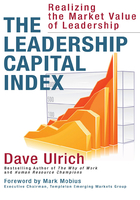
Requirements of a Leadership Capital Index
A leadership capital index enables investors and others to systematically and predictably determine the quality of leadership within a firm. As noted in Chapter 1, an index is not a standard for leadership; rather, it is a rigorous and replicable set of guidelines that investors can use to improve their assessment of leadership capital as they make investment decisions.
Today, the components of a leadership capital index often come with confusing concepts and murky language. Would the index refer to
 Ability to make decisions?
Ability to make decisions?
 Authenticity?
Authenticity?
 Charisma?
Charisma?
 Style?
Style?
 Ability to meet expectations?
Ability to meet expectations?
 Emotional intelligence?
Emotional intelligence?
 Ability to build effective teams?
Ability to build effective teams?
 Experience in the industry?
Experience in the industry?
 Personal reputation?
Personal reputation?
 Personal attributes?
Personal attributes?
 Use of power and influence?
Use of power and influence?
 The leadership pipeline?
The leadership pipeline?
 Talent in general?
Talent in general?
 Competence or commitment of people throughout the organization?
Competence or commitment of people throughout the organization?
 Organizational culture?
Organizational culture?
 Pay philosophies of the organization?
Pay philosophies of the organization?
 Investment in management or human resource practices like staffing and training?
Investment in management or human resource practices like staffing and training?
 Organizational structure and governance processes?
Organizational structure and governance processes?
To condense the broad domain of leadership, organization, talent, culture, and human capital into an index that investors can actually use to determine leadership readiness, these complex and at times confusing concepts need to be simplified into a practical framework.
At first glance, it may sound impossible, but this sort of thing has been done before. Consider the credit ratings index, for example. Standard & Poor’s (S&P) created an analytic framework in structured finance securitization that includes five domains:
 Credit quality of the securitized assets
Credit quality of the securitized assets
 Legal and regulatory risks
Legal and regulatory risks
 Payment structure and cash flow mechanics
Payment structure and cash flow mechanics
 Operational and administrative risks
Operational and administrative risks
 Counterparty risk
Counterparty risk
Once these five domains are identified, S&P then creates a credit ratings index with specific factors and metrics within each domain.
Likewise, a leadership capital index will need to synthesize the various and muddled concepts related to leadership capital and provide a discipline to rigorously track them. As discussed in Chapter 1, I am beginning the development with a minimum viable process (1.0) that focuses attention on leadership issues and synthesizes previous work, yet has room for improvement over time. Based on this intent, a leadership capital index has two dimensions, or domains: individual and organizational (see Figure 2.1). Individual refers to the personal qualities (competencies, traits, characteristics) of the top leader and key leaders in the organization. Organizational refers to the systems (often called human capital) these leaders create to manage leadership throughout the organization, as well as to the application of organization systems to specific business conditions. Using these two domains, existing leadership and human capital work can be synthesized into an index that investors can use to inform their leadership valuation decisions.
